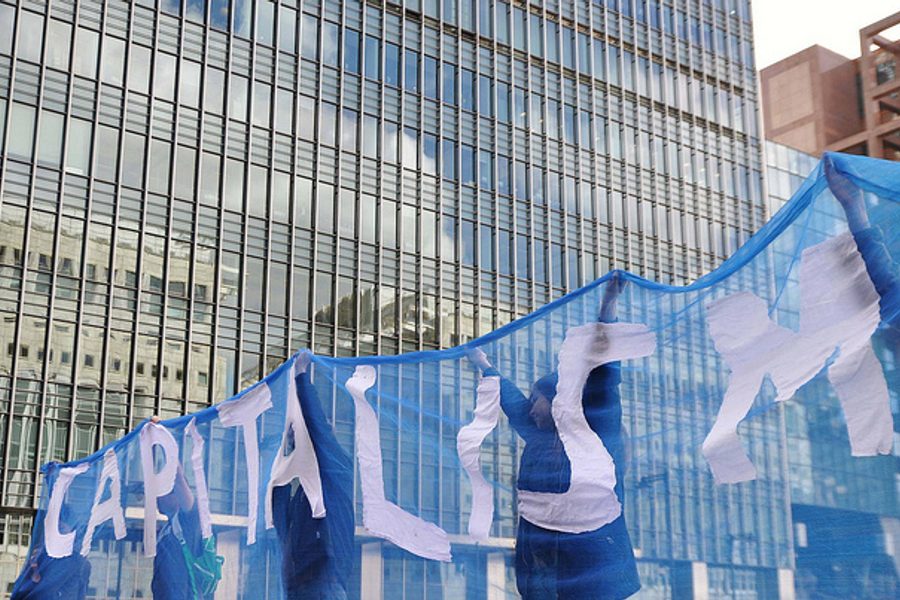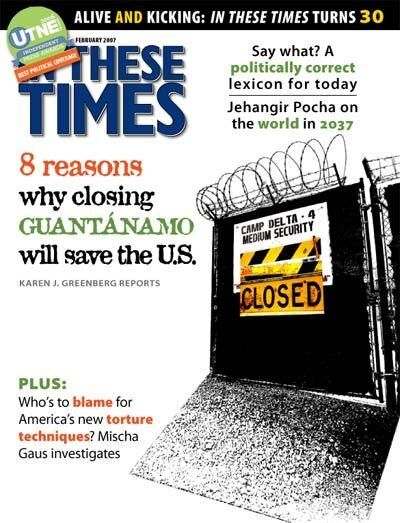Eyes Off the Prize
As Iraq dominates U.S. attention, China, India and Iran are emerging as the next world powers
Jehangir Pocha

About 30 years ago, U.S. diplomats famously dismissed the civil war raging in the jungles of Cambodia as a “sideshow” to the Cold War. Callous as that was, the uncomfortable fact remains that the diplomats were probably right. As bloody and heartrending as the situation in Cambodia got by 1977, in the end it appears to have had only a limited bearing on the wider historical forces at work in the world, adding a further dimension of sheer meaninglessness to the tragedy and trauma that still haunts millions of Cambodians.
Today, headlines are fixated on the gore and chaos unfolding in Iraq. The conflict there has been shaping the outcome of the elections in many Western nations, and is certain to be the most contentious foreign policy issue in the 2008 U.S. presidential election. Yet this unrelenting focus on Iraq obscures the reality that in another 30 years the Bush administration’s adventure there will probably look like the Cold War-era face-off in Cambodia does now – a tragic mistake fuelled by hubris that cost countless innocent lives and billions of dollars, but which ultimately had only a limited effect.
Instead, the principal dynamic shaping life in the year 2037 will be the re-emergence of three ancient nations: China, India and Iran. Their powerful economies, muscular militaries, ambitious politicians, nationalistic populaces and resurgent cultures will irrevocably alter the lives of the 2.9 billion people who will then be living within their borders. But beyond that, these three countries will radically alter the balance of power in the world and give people and nations everywhere a new impetus to recreate their own societies.
That this will happen is certain. What’s up for grabs is what it will mean for the United States and the world. Yet the United States and most other countries seem to be only marginally prepared to deal with this nascent new world order.
China is the nation whose resurgence is best understood in the West. But despite the media hype around China, the country is only of marginal interest to the average American citizen and policymaker, as illustrated by the fact that when Chinese President Hu Jintao visited Washington earlier this year President Bush didn’t even offer him a state dinner, dismissing him with just a hurried lunch. India, for all the ferment and change it is experiencing, receives hardly any diplomatic or media attention. Both official and general perceptions of this complex and contradictory country generally revolve around banal sound bites of it being a “software superpower.” And, because official and public views of Iran are so dogged by miscomprehension and prejudice, the entire country is seen almost exclusively through a political lens, even though Western diplomats themselves tell us the Islamists ruling Tehran are almost totally out of step with the rest of the country.
The relatively few editors, businessmen, academics and officials committed to studying China, India and Iran provide us with invaluable insights into these countries. But they still generally label what we are seeing in these three ancient civilizations as “amazing change.” In reality, it is much more: not just change or evolution, but a paradigmatic shift that will challenge the basic framework of the post-WWII world.
— — — — — — — — — –
As with any new idea, the world is trying to cope with the changing dynamics in China, India and Iran by squeezing them into existing structures and processes. But the national ambitions of the rising East and the sheer scale of their change will force a major, if not complete, re-thinking of the global system.
Just as the turn of the last century saw Germany, Japan and Italy demand (but so misguidedly pursue) their own place in the sun, China, India and Iran will soon demand that the global system that currently protects the United State’s interests adapt to accommodate their own economic and strategy ambitions. The most immediate impact will be on the three pillars of U.S. dominance: the global financial system that has the U.S. dollar at its center, the global oil and gas trade which the United States currently controls, and America’s “soft power,” or its ability to win friends and arguments based on the popularity of its culture and values.
— — — — — — — — — –
Today’s global financial system is based around an informal but effective agreement labeled Bretton Woods II, which revolves around the idea that, de facto, the world is following a regime of fixed global exchange rates just like the original Bretton Woods regime maintained de jure from 1945 to 1973. While the original Bretton-Woods was a formal system that fixed nations’ currency rates to their gold reserves, Bretton Woods II is an informal arrangement that pegs exchange rates to the U.S. dollar.
Currently, more than 30 nations, including China and Saudi Arabia, have their exchange rates pegged to the dollar in one form or another, allowing them to export their goods into the United States and maintain huge trade and current account surpluses. This arrangement works as long as this surplus is used to purchase U.S. dollar-denominated debt, including the U.S. national debt. With this money coming from China, Saudi Arabia and other countries, the United States can then finance its $8 trillion budget deficit. This allows the U.S. Federal Reserve to produce enough money to stimulate spending by U.S. consumers, who will then buy Chinese-made clothes and home theatre systems (or Saudi oil) via the “fixed” exchange rate. The Asian countries then invest their profits into U.S. T-bills – in other words, lending it back to the United States so the cycle can repeat itself over and over again.
This system has worked well until now. China is an exporting juggernaut and has about $1 trillion in foreign reserves, most of which is used to buy U.S. debt, including $350 billion in U.S. T-bills. This has allowed Americans to live beyond their means on someone else’s money, while also allowing the United States to raise its huge debt in its own currency, thereby neutralizing any currency risk.
This can happen because international loans are mostly denominated in dollars and when a country borrows too much its own currency depreciates, thus making it more expensive for the borrowing country to pay back its dollar-denominated debts. So, for example, if India borrowed $1 billion from the World Bank in January 2006 when the exchange rate was 10 rupees to the dollar, that means in rupee terms India borrowed 10 billion rupees. If India borrows another $1 billion in 2007 and investors deem that excessive, the value of the rupee will fall to, say, 12 rupees to a dollar, which means it will now cost India 12 billion rupees to pay back the original $1 billion it borrowed.
Because the United States borrows in its own currency, it is immune from this currency exchange trap. The $1 billion the United States borrows remains $1 billion even if the dollar devalues globally. In fact, it is the lenders who bear the cost of the devaluation, as the $1 billion they get back will be worth less vis-à-vis their own and other currencies.
What policy makers should now begin to grapple with, according to former U.S. Treasury Secretary Lawrence Summers, is that the rationale for China to buy U.S. debt is slowly fading. Beijing’s huge stock of dollars is threatening its own economy with inflation and the United States’ mammoth debt is making China and other countries wonder if U.S. dollars are truly a wise investment. In the last year alone, China, the United Arab Emirates, Russia, Italy, Switzerland, Qatar and New Zealand have all said they will reduce their U.S. dollar holdings and buy more gold and Euros.
China also realizes its dollars are subsidizing U.S. growth when they could be used on domestic development projects and/or lent to other Asian nations with whom it wants to buy influence at the expense of the United States. Though Chinese officials are generally deferential to the United States in their public comments, many say privately that they realize that China is lending money to the United States, which in turn is lending dollars to global institutions such as the International Monetary Fund (IMF) and thereby acquiring greater clout over the global financial system, particularly over the countries dependent on the IMF for loans.
Increasingly Beijing, New Delhi and other Asian nations, including Thailand, are talking about using their surplus dollars to create their own financial institutions, such as an Asian Monetary Fund, that would lend Asian surpluses to Asian borrowers. Not only would this diminish the United States’ ability to dictate economic policy to borrowers, it would cement regional ties by giving Asian nations a vested interest in each other’s development and stability.
— — — — — — — — — –
Meanwhile, Iran poses its own threat to the dollar. Currently, the global oil and natural gas trade is conducted mainly in U.S. dollars. Since countries need to pay for their oil in dollars, they strive to acquire them, and this further strengthens both demand for the dollar and its central role in the world economy. But Iranian President Mahmoud Ahmadinejad has begun talking about selling Iranian oil and gas for Euros and other internationally traded currencies. If Iraq does indeed fall into the Iranian orbit, as many fear it will, and if Iran can get Iraq to follow suit, along with Iran’s ally Venezuela, about a third of the world’s energy would no longer be traded in the dollar, but in Euros or other currencies.
Another worry for Washington is that Tehran and Beijing have close military ties and are deepening their efforts to keep the United States out of energy-rich Central Asia, an area that has always been seen by Beijing, Moscow, Tehran and New Delhi as their backyard. In the months following the 9/11 attacks, Washington surprised these regional powers by using the international alarm over global terrorism to establish new military bases in Tajikistan, Uzbekistan and Kyrgyzstan. Washington also used its clout to buy major oil fields in the area and created the strategically important Baku-Tbilisi-Ceyhan pipeline, which allows Western countries to directly access the Caspian Sea’s energy reserves without needing to go through Russia or Iran.
Shi Yinhong, director of the American Studies program at the People’s University in Beijing, is concerned that tensions in the region heightened last year when the United States supported the “color” revolutions that toppled pro-Russian and pro-Chinese allies in Ukraine, Georgia and Kyrgyzstan, and replaced them with pro-Western democrats. In response, the region’s rising powers and disgruntled dictators are pooling their umbrage against the United States’ geopolitical dominance under the diplomatic shell of the six-nation Shanghai Cooperation Organization (SCO), says Madhav Nalapat, professor of geo-politics at the Manipal University in southern India. “The SCO is well on track to becoming an organization that directly challenges the geopolitical reach of the United States,” he says. “China is in the driver’s seat because it sees itself as the next United States.”
Initially, the Chinese-founded SCO had only five other members: Russia, Kazakhstan, Uzbekistan, Tajikistan and Kyrgyzstan. But in July 2006, Iran and India (as well as Pakistan and Mongolia) were inducted as observers and are expected to become full members soon. This would formally unite China, Russia, India, and Iran in a quasi-military alliance for the first time, fueling talk of an emerging axis between these four powers that could balance, and maybe even threaten, U.S. influence in the region.
Indications of this crested this past year when Moscow, Beijing and New Delhi defended Tehran against the United States’ attempts to curb its nuclear activities by imposing sanctions. In fact, New Delhi, often seen as the most pro-United States of the four countries, even threatened to walk away from a much sought-after civilian nuclear deal of its own with the United States if Washington pushed it too hard to support the sanctions against Iran. The SCO has also asked the United States to withdraw all of its troops from the K-2 air base it set up in Kazakhstan just after the 9/11 attacks. Meanwhile, both Russia and India have established new military bases in Tajikistan, not far from the U.S. base there.
The economic endgame in all this is to dilute Washington’s hold over the Caspian Sea’s energy reserves, says Robert Karniol, Asia-Pacific editor for Jane’s Defense Weekly. China and India, the world’s fastest-growing energy consumers, want to divert Central Asia’s energy resources toward their own economies, and Iran and Russia, the region’s largest energy suppliers, are keen to reduce their dependence on sales to the West.
Both Russia and India have begun to talk of a Central Asian “energy club” that would create a regional gas grid, pipeline network and oil market, and China is already constructing a pipeline through Kazakhstan that would give it direct access to Russian and Caspian Sea oil. New Delhi and Beijing have raised Washington’s ire by backing a more audacious proposal to convert the prized Baku-Tbilisi-Ceyhan pipeline, which has been designed to bring gas to Europe, into a supply route for Asia. New Delhi wants to extend the pipeline to Syria, where oil could be loaded onto tankers and shipped to Asia through the Red Sea.
— — — — — — — — — –
Perhaps most significantly, however, the rise of China, India and Iran is increasingly weighing down what Joseph Nye, a former chairman of the National Intelligence Council, which provides the president and intelligence agencies with National Intelligence Estimates, calls the United States’ “soft power” – the attractiveness of American ideas, culture and values.
After the end of the Cold War, a U.S.-defined system of secular democracy and free markets was widely hailed as the universal governance model. Now, the increasing diffusion of Chinese, Indian and Iranian ideas, culture and values is increasing the soft power of these countries. This is most evident in the increasing global appetite for their cultural exports, including movies, books, fashion and art. As more and more people – including Westerners – consume Chinese, Indian and Persian culture, they are developing a greater appreciation and regard for these countries, making it easier for Beijing, New Delhi and Tehran to put their points of view out to the world.
For example, the success of the Chinese Communist Party in bringing more people out of poverty than any other country in history and in rebuilding China’s global clout is making China, not the United States, the model for many nations, particularly in Africa and Asia. This sentiment was loudly mouthed by some African leaders during the recent Africa summit in Beijing. Even in democratic India, ministers, businessmen and laypeople often talk admiringly of China’s one-party system, wishing its effectiveness for themselves.
For its part, Iran is directly challenging the United States’ democratization push in the Middle East with its own unique notion of Islamic democracy. Given the way things are shaping up in Iraq, Palestine and Lebanon, it’s likely that Iranian ideas and values and not American ones will shortly become the dominant force in the region.
U.S. attempts to defend democracy after the recent military coup in Thailand have also been undermined by China, and, more disturbingly, Beijing and New Delhi have been the main opponents of a U.S. plan to take military and economic action against the government in Sudan, which is committing genocide in the Darfur region. As a U.S. diplomat in Beijing puts it, “We just cannot exert our will anymore. We have to consider what China and India think before we do anything.”
If the trajectory of China, India and Iran’s resurgence is not derailed by the substantial problems facing these countries – poverty, corruption, religious turmoil and widening imbalances in income – the world of 2037 will look substantially different from today, with Americans carrying much of the negative burden of the change. Yet, as Nye points out in his book, The Paradox of American Power, any U.S. attempt to undermine or contain the emergence of these new powers could backfire just like Britain, France and Russia’s attempts to contain Germany, Japan and Italy backfired a century ago. There is already a growing sense in China, India and Iran that the neo-conservatives are likely to push the United States into repeating the mistakes of colonial Europe. The much-touted Project for the American Century developed by Paul Wolfowitz and company is seen by many analysts in China, India, and Iran as a direct challenge to their vision of an Asian Century. The ensuing resentments are already igniting new waves of anti-Americanism in these countries and elsewhere.
A stable and balanced world order will only emerge if the United States can arrive at negotiated understandings with China, India and Iran over how their new and growing financial, energy and military interests can be achieved within a globally acceptable framework. Even if this approach is pursued with the best of intentions, it could short-circuit under the burdens of the complexities and contradictions that plague relations and interests between the West and the rising East, as well as between China, India and Iran themselves.
Yet neither the United States nor Europe is investing the time and resources required to engage astutely with a resurgent China, India and Iran. Unlike the men, materials and money invested in understanding and dealing with the Soviet Union during the Cold War, the tidal wave of change coming from the East remains on the periphery of Western mindsets.
Thirty years from now, the greatest cost of the war in Iraq might well be that it proved to be the siren song that lured the United States away from its natural if challenging course, onto the rocks.







